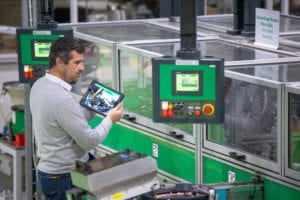Owners of colocation data centers have seen some dramatic changes to traffic and workload patterns during pandemic-driven lockdowns. A shift to remote working and greater online service delivery have prompted many hyperscale customers to increase their dependence on cloud and digital services.

Despite the heavier workloads, customer expectation is that systems availability and uptime will remain near 100%. Colocation providers sign service level agreements (SLAs) that commit to achieving at least 99.99 percent uptime in any calendar month. Customers can include internet giants, private or hybrid IT cloud services, content providers, telecom networks inter-connection . . . all hosting their infrastructure in a colocation space. If services drop below that agreed-to uptime, these customers will either receive service credits in return, or the provider is obligated to return money to the customer.
For these reasons, colocation providers are constantly searching for new technologies that assure ever higher degrees of resilience and systems availability. Recently, their search has pointed them toward industrial control systems. Across the industrial world, proven technologies like programmable automation controller (PAC) hardware and supervisory control and data acquisition (SCADA) systems software, have, for years, supported critical segments, such as the chemical and nuclear power industries where failure is not an option and security, control and redundancy are literally a life and death matter.
Access White Paper 285: Comparing IEC 61850 vs. Traditional Monitoring, Protection and Control Solutions in Large Data Centers
Industrial control technology’s role in colocation data centers
Some colocation businesses are exploring how industrial automation technologies can enable more resilient cooling and electrical management systems as part of their overall business continuity plan. Developing such solutions requires a unique level of expertise that combines deep knowledge across three important environments: building management; data center management; and industrial automation OT (operations technology).
Several businesses are currently collaborating with Schneider Electric, which has a long history as a global provider of solutions across all three environments. Schneider Electric has recently released solutions that apply industrial automation technology to specific colocation use cases. These solutions, known as Modicon, integrate both Programmable Automation Controller (Modicon M580) and SCADA benefits and apply them to some key colocation data center availability-related use cases. Below are several examples:
- Redundant chiller plants – In high power density colocation environments, where two separate chiller plants exist, and where one is capable of rebalancing the cooling capacity of the other, if more than one critical cooling equipment fails (e.g. Two chillers simultaneously in the same cooling plant), then the IT equipment will cease functioning in minutes. In this type of critical situation, advanced controller – like PAC M580 solution – is able to rebalance the cooling power from one plant to another in real time as a “fault tolerant” system to maintain cooling capacity. And in a less critical case – when one critical equipment (such as chiller) is in maintenance mode while chiller plant is design in N+1 redundancy – the combination of the two plants can deliver the same power capacity if a failure occurs.
- More reliable backup power – Back-up generation is another critical system of the electrical solution in data centers. Back-up generation plants are often design in N+1 or N+2 redundancy to optimize CapEx and centralized, which required “fault tolerance” and advanced features and protocols to start/stop/synchronize . . . units between them and with the normal operation power source from utilities. The programmable automation controller manages and secures all sequences of large back-up gen sets to maintain continuity of power in all circumstances.
- Easier data aggregation and monitoring of complex electrical systems – The PAC supervisor can also act as a bridge between automation and energy management systems. When the IEC 61850 standard is implemented, the PAC is compliant with this standard and can be used to aggregate, control and interface SCADA with the electrical power management system (EPMS). The controller acts as a concentrator of data and combines data from medium voltage (MV) and low voltage (LV) systems when needed. This greatly simplifies the work involved in designing, deploying, controlling and monitoring complex electrical systems using IEC61850.
- Fault tolerant monitoring of data center facilities – Systems that incorporate advanced process automation software and controllers, SCADA and EPMS and that aggregate data from hardware, I/0, communications cards, PLCs, automation servers, meters, sensors and gateways, among other devices, also support colocation efforts to enable “hot / standby” capabilities (i.e., if the active system or component fails, monitoring and issue identification enables for the quick substitution of a hot standby system). This approach has been applied for both data center power and communications systems. The system enables high availability on the programmable automation controller (PAC) CPU, power supply and control aspects of the data center. The architecture of the solution enables operators to manage these three aspects from one integrated environment.
Benefits of industrial automation solutions for colocation providers
Modicon PAC technologies have evolved over many years. In fact, Modicon controllers were among the first automation controllers ever manufactured. Over the years, they have been refined to address changing customer business requirements. Today, these sophisticated technologies are beginning to migrate into data centers where they are addressing the challenges of both colocation providers and internet giants. Use cases are growing and these technologies provide users with both advanced cybersecurity (SIL2), and architectures imbedded with OPC UA IPV6, and IEC 61850 compliant technologies.
Some major colocation providers have been jointly evaluating and testing the Modicon PAC technologies in Schneider Electric labs over the last three years. They have progressed through pilots and migrated to the live production system implementation phases, issuing high evaluation grades in the areas of availability, openness and quality. Benefits experienced thus far include higher systems resilience and clean integration of processor, communication and power supply systems.
To learn more about how IEC 61850 can be applied to colocation data centers, download the new White Paper 285, Comparing IEC 61850 vs. Traditional Monitoring, Protection and Control Solutions in Large Data Centers.
Contributor
 Florent Lacharme Florent Lacharme, Schneider Electric Offer Category Director, Industry Business
Florent Lacharme Florent Lacharme, Schneider Electric Offer Category Director, Industry Business



